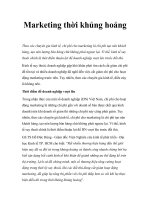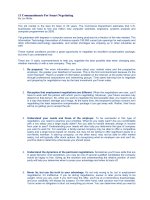Niche Marketing for Small Ruminants docx
Bạn đang xem bản rút gọn của tài liệu. Xem và tải ngay bản đầy đủ của tài liệu tại đây (120.95 KB, 4 trang )
UNP-98UNP-98
UNP-98UNP-98
UNP-98
ALABAMA A&M AND AUBURN UNIVERSITIES
Niche Marketing for Small
Ruminants
Introduction
The meat goat industry is one of the fastest
growing components of agriculture within the
United States. According to the United States
Department of Agriculture's National Agricul-
tural Statistics Service, the overall goat popula-
tion continues to increase annually throughout
the United States. While the sheep industry
has seen a declining interest in wool sheep,
there has been an increasing interest with
raising hair sheep (meat-type sheep). Opportu-
nities exist to produce and market sheep and
goats because of the significant influx of immi-
grants to the United States. Goat meat is a
commonly consumed red meat throughout the
world. As various ethnic groups from around
the world relocate to the United States, they
actively seek goat and lamb meat. Such de-
mand creates an ideal marketing opportunity
for goat and sheep producers.
Although marketing opportunities are
increasing for goats and sheep, knowledge
regarding effective marketing opportunities
may be a limiting factor for potential and
existing producers. They should be aware of
their marketing outlets and options so that they
can determine the most effective and economi-
cally beneficial opportunity for their situation.
Small ruminant producers could fail to
receive maximum potential market price when
selling their animals if they are not well versed
regarding how and when to selectively market
their product. Producers probably are aware of
direct and indirect marketing opportunities, but
they may be unaware of peak marketing op-
portunities based on ethnic holidays, consumer
preference, and other situations. Based on
these conditions, there are times of the year
when buyers are willing to pay more for goats
and sheep. Without adequate market research,
producers may not receive a fair market price
for their product.
www.aces.edu/urbanwww.aces.edu/urban
www.aces.edu/urbanwww.aces.edu/urban
www.aces.edu/urban
Your Experts for Life
Marketing
Livestock marketing involves two compo-
nents: activities associated with the physical
movement and transportation of livestock and
pricing or placing a value on livestock. Direct
marketing involves buyers who purchase
livestock directly from a farmer rather than
through an intermediate market or party. The
producer or seller must effectively and effi-
ciently market his or her product in order to
receive a premium price. Indirect marketing
situations involve the movement of livestock
with the services of an intermediary (middle
man). The intermediary who assists with the
transaction expects to receive a commission or
percentage in exchange for his or her efforts
to facilitate the sale. This type of transaction
offers an ideal situation for the producer who
needs to move animals at any given time.
Ethnic Groups and Preferences
Those who consume lamb and goat tend to
be immigrants from other countries where
they traditionally eat these meats. Ethnic
groups relocating to the United States with a
preference for goat and lamb tend to come
from (but are not limited to) such countries as
Africa, the Caribbean, Mexico, Asia, Europe,
and Middle Eastern and Latin American coun-
tries. People from these areas tend to relocate
to areas within the United States where others
with the same ethnic background have already
settled. If a goat or sheep producer can iden-
tify locations where there is a concentration of
similar ethnic population, the farmer can make
reasonable efforts to successfully market his
or her product within these communities.
However, the producer needs to understand
consumer preferences.
For example, consider the following options
when marketing to ethnic groups:
• Do the customers prefer male or female
goats? If male, do they prefer intact (with
testicles) or castrated males?
• What goat or sheep age do the customers
prefer?
• Does this group prefer a small or large
goat?
• Do the customers prefer a live animal or an
animal processed in a particular fashion?
When or where do they prefer the animal
to be processed?
Market success will be limited if sellers do
not consider these factors.
Ethnic and Faith-Based Holidays
In certain times during the calendar year,
ethnic or religious holidays contribute to in-
creased lamb and goat meat sales. The table
below shows general ethnic or religious holi-
days during which goat or lamb may be served
with meals.
These occasions may vary from year to
year, so consult an appropriate calendar for
specific dates and times of the year. Preference
for animal type, age, gender, and processing
also may vary based on ethnicity and holiday.
Be sure to research your market carefully.
Special Occasions
Religious holidays are not the only events
when goat or lamb meat is served. Ethnic
groups may roast a lamb or goat during Ameri-
can holidays such as Christmas, New Year's,
Memorial Day, July 4, and Labor Day. It is not
unusual to serve goat or lamb at birthday
parties, weddings, baptisms, graduations,
anniversaries, and other celebrations where
family and friends gather to feast.
Utilizing Livestock Sales Facilities
Rather than try to target individual buyers,
producers may choose to transport their ani-
mals to central locations where small ruminants
are bought and sold in quantities. The animals
then are hauled to a processing facility where
they are further processed and then shipped to
retail markets such as meat markets and
grocery stores. This type of market is known as
a terminal market and best serves producers
who have a number of animals that need to be
sold at one time.
A sale barn requires preplanning when a
producer or seller wants to market his or her
product for ethnic holidays. The willingness to
pay is determined by the buyers in the audi-
ence. If there are insufficient serious or com-
mercial buyers, bid prices may be low. If there
are serious individual and commercial buyers,
the bid prices likely will be driven upward. Price
bids by commercial buyers may be affected by
potential market demand and fluctuating sup-
ply. Prices tend to increase during peak market
demand and upcoming ethnic holidays. During
the summer, bid prices generally are lower as
demand is lower and supply is plentiful. In a
sale barn situation, the seller has no control
over bid prices.
Christian Holidays
Epiphany
Western or Roman
Easter
Eastern or Greek
Easter
Christmas
Jewish Holidays
Passover/Pesach
Rosh Hashanah
Chanukah
Islamic Holidays
Start of Ramadan
Eid ul-Fitr
Eid ul-Adha
Muharram/Islamic
New Year
Mawlid al-Nabi
Hindu Holidays
Navadurgara or
Navratra Dasshara
or Dassai
Diwali
2 Alabama Cooperative Extension System
When strategically planning for marketing
animals at a livestock sale, it is best to sell
products in advance of a holiday or event.
Consumers could be disappointed if they arrive
a day or two before a special holiday and
expect to receive a premium price. The holiday
will have passed by the time an animal arrives
at the processing facility or retail location.
Considerations
When direct marketing goats and sheep to
individuals, the seller must assess who is
responsible for transportation and make pro-
cessing arrangements even if the animal will be
processed on site. If the seller is willing to allow
the animal to be processed on site, he or she
must decide who is responsible for disposing of
the offal. Will there be an extra charge for on-
site processing? Only the farmer knows if he or
she wants to deal with such details.
Other factors such as federal, state, and
local health regulations, should be considered
as well as recent nuisance laws and animal
rights groups. The best option may be for the
seller to specify up front that on-site processing
is prohibited and whether the buyer is respon-
sible for transportation and other processing
arrangements. If the animal is to be trans-
ported by the seller, determine if a transporta-
tion fee is involved. Again, this takes greater
commitment on the part of the seller because
processing and logistics are factors to consider
when developing marketing strategies.
Conclusion
When attempting to market goats or sheep
for ethnic holidays and special occasions, the
farmer becomes more than a producer-he or
she becomes a marketing specialist. It is neces-
sary to understand consumer preferences, as
well as ethnic holidays and other special occa-
sions. In addition, producers should be aware of
the age, gender, and type of animals preferred.
Each producer must readily identify methods to
effectively target clientele and determine what
promotional efforts will have significant results,
while remaining cost effective.
Small ruminant producers may need to
consider developing a marketing plan in order
to ensure success at targeting marketing op-
portunities. Documentation will help the pro-
ducer effectively and efficiently determine
where the demand is coming from, who the
target clientele is, the times of the year for
peak demand, what type of product is ex-
pected, and effective marketing strategies to
reach potential markets. There are numerous
ethnic groups in the United States that con-
sume sheep and goat meat. The United States
Department of Agriculture has determined,
based on marketing reports, that goat and lamb
meat demand exceeds current local supplies. As
a result, we are importing more goat and lamb
than is being produced within the United
States. It is up to each producer to determine
the best niche marketing practices that benefit
the client and the producer.
References
Piano Independent School District. (2007/08).
Religious/
ethnic observances and/or holy day 2007-08.
Ethnic/
Religious Holidays. Retrieved May 18, 2007, from http:/
/www.pisd.edu/common/calendar/documents/2007-
08ReligiousHolidays.pdf.
Niche Marketing for Small Ruminants 3
Robert Spencer, Urban Regional Extension Specialist, Alabama A&M
University
For more information, call your county Extension office. Look in your telephone directory
under your county’s name to find the number.
Issued in furtherance of Cooperative Extension work in agriculture and home economics, Acts of May 8 and
June 30, 1914, and other related acts, in cooperation with the U.S. Department of Agriculture. The Alabama
Cooperative Extension System (Alabama A&M University and Auburn University) offers educational
programs, materials, and equal opportunity employment to all people without regard to race, color, national
origin, religion, sex, age, veteran status, or disability.
New September 2007; UNP-98
© 2007 by Alabama Cooperative Extension System. All rights reserved.
UNP-98UNP-98
UNP-98UNP-98
UNP-98
Your Experts for Life









